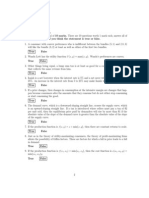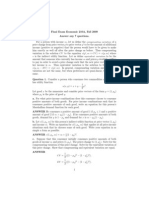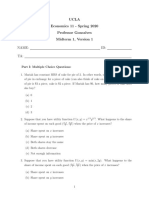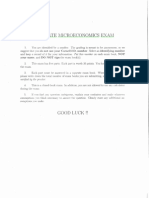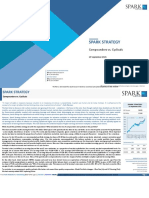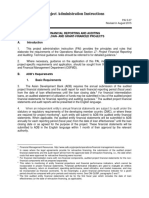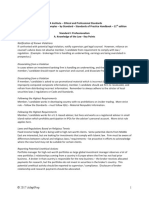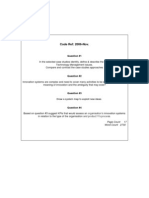Name and Surname….…………………….……………….….
Student ID ………………………………………………...
Course and Class …………….…...………………………...
Signature………………………..…………...…..…………..
Penalty
General exam
MICROECONOMICS
[MOCK -EXAM]
Instructions
Please, answer all questions below. Clearly explain your answers. Use only the space provided. If
necessary, you may use the last page to complete your answers, clearly denoting the number of the
question you are referring to. For drafting, use exclusively each page’s back side.
For codes 4007, 5013 and 6006 handing in of the exam automatically implies acceptance of the
grade.
Time available: 2 hours
1
�SECTION 1 [suggested time: 60 minutes]
Answer all 8 questions
Decide whether the following statements are TRUE, FALSE or UNCERTAIN (i.e. they are true only
under specific hypothesis not contained in the statement). Justify the answer. [The justification is
more important than the initial answer being true, false or uncertain.]
1) Cesare is a heavy smoker and eager for books. His preference for cigarettes (x) and books (y)
are described by the following utility function: U(x,y) = x·y. A recent increase in the price of
cigarettes will induce Cesare to smoke less, and will increase its demand for books.
…………………………………………………………………………………………………………
…………………………………………………………………………………………………………
…………………………………………………………………………………………………………
…………………………………………………………………………………………………………
…………………………………………………………………………………………………………
…………………………………………………………………………………………………………
…………………………………………………………………………………………………………
…………………………………………………………………………………………………………
2) Sara considers present consumption (C 0 ) and future consumption (C 1 ) as normal goods. She is
saving for her wedding. An increase in the interest rate will certainly induce her to save more.
…………………………………………………………………………………………………………
…………………………………………………………………………………………………………
…………………………………………………………………………………………………………
…………………………………………………………………………………………………………
…………………………………………………………………………………………………………
…………………………………………………………………………………………………………
…………………………………………………………………………………………………………
…………………………………………………………………………………………………………
3) Giacomo’s demand function for good x is: x = 10 - px The price of x is equal to 5. At the current
price, Giacomo’s demand is inelastic.
…………………………………………………………………………………………………………
…………………………………………………………………………………………………………
…………………………………………………………………………………………………………
…………………………………………………………………………………………………………
…………………………………………………………………………………………………………
…………………………………………………………………………………………………………
2
�…………………………………………………………………………………………………………
…………………………………………………………………………………………………………
4) A production function characterized by increasing returns to scale cannot have decreasing
marginal returns in any input.
…………………………………………………………………………………………………………
…………………………………………………………………………………………………………
…………………………………………………………………………………………………………
…………………………………………………………………………………………………………
…………………………………………………………………………………………………………
…………………………………………………………………………………………………………
…………………………………………………………………………………………………………
…………………………………………………………………………………………………………
5) In a duopoly, with identical firms and homogeneous product, total surplus does not depend on
the type of competition (Cournot vs. Bertrand).
…………………………………………………………………………………………………………
…………………………………………………………………………………………………………
…………………………………………………………………………………………………………
…………………………………………………………………………………………………………
…………………………………………………………………………………………………………
…………………………………………………………………………………………………………
…………………………………………………………………………………………………………
…………………………………………………………………………………………………………
6) Piero is a risk lover. He can choose among two alternatives: (i) a lottery that pays 100 euro with
probability 0.5 and nothing with probability 0.5; (ii) a fixed amount of 55 euro. Piero will
decide to participate in the lottery.
…………………………………………………………………………………………………………
…………………………………………………………………………………………………………
…………………………………………………………………………………………………………
…………………………………………………………………………………………………………
…………………………………………………………………………………………………………
…………………………………………………………………………………………………………
…………………………………………………………………………………………………………
…………………………………………………………………………………………………………
7) In a game where the two players have no dominant strategies, a Nash equilibrium cannot exist.
3
�…………………………………………………………………………………………………………
…………………………………………………………………………………………………………
…………………………………………………………………………………………………………
…………………………………………………………………………………………………………
…………………………………………………………………………………………………………
…………………………………………………………………………………………………………
…………………………………………………………………………………………………………
…………………………………………………………………………………………………………
8) In the market for used cars, there are good cars (B) and lemons (C). The buyers’ reservation
price is 8 for good cars and 6 for lemons. The sellers’ reservation prices are, respectively, 4 and
3. Sellers can sell the car with a warranty. Buyers are willing to pay 8 for a car with a warranty,
otherwise they will expect the car to be a lemon and pay 6. The warranty is a cost for the sellers,
because it requires to have the car serviced. Sellers of lemons are not encouraged to provide the
warranty if the cost of it is at least 2.
…………………………………………………………………………………………………………
…………………………………………………………………………………………………………
…………………………………………………………………………………………………………
…………………………………………………………………………………………………………
…………………………………………………………………………………………………………
…………………………………………………………………………………………………………
…………………………………………………………………………………………………………
…………………………………………………………………………………………………………
4
�SECTION 2 [suggested time: 60 minutes]
Solve all 4 exercises.
Exercise 1
Guglielmo loves having dinner with pizza (P) and Coca Cola (C). His preferences are characterized
by the following utility function: U(P,C) = min{3P;C}. The price of pizza is 4 euros, the price of
Coca Cola is 2 euros. Guglielmo’s income is 150 euros.
a) Which type of goods are these? Represent in the graph below the indifference curves, drawing
at least two indifference curves, and the budget constraint, clearly indicating the values of the
intercepts and the slope.
…………………………………………………………………………………………………………
…………………………………………………………………………………………………………
…………………………………………………………………………………………………………
…………………………………………………………………………………………………………
…………………………………………………………………………………………………………
…………………………………………………………………………………………………………
…………………………………………………………………………………………………………
…………………………………………………………………………………………………………
b) Determine the optimal consumption bundle and depict it in the previous graph.
…………………………………………………………………………………………………………
…………………………………………………………………………………………………………
5
�…………………………………………………………………………………………………………
…………………………………………………………………………………………………………
…………………………………………………………………………………………………………
…………………………………………………………………………………………………………
…………………………………………………………………………………………………………
…………………………………………………………………………………………………………
c) What would happen to the consumption of the two goods if the price of Coca Cola decreases,
given the same income?
…………………………………………………………………………………………………………
…………………………………………………………………………………………………………
…………………………………………………………………………………………………………
…………………………………………………………………………………………………………
…………………………………………………………………………………………………………
…………………………………………………………………………………………………………
…………………………………………………………………………………………………………
…………………………………………………………………………………………………………
6
�Exercise 2
In the short run, in the perfectly competitive market for DVD, there are 40 identical firms. The cost
function of each firm is .
a) What is the supply curve of the single firm? For which values is the supply equal to zero?
Derive also the market supply function.
…………………………………………………………………………………………………………
…………………………………………………………………………………………………………
…………………………………………………………………………………………………………
…………………………………………………………………………………………………………
…………………………………………………………………………………………………………
…………………………………………………………………………………………………………
…………………………………………………………………………………………………………
…………………………………………………………………………………………………………
b) Market demand is YD = 1800 – 20p. Compute the equilibrium price, quantity and profits for
the single firm, and the quantity exchanged overall in the market. According to your results, is it
possible for other firms to enter the market in the long run?
…………………………………………………………………………………………………………
…………………………………………………………………………………………………………
…………………………………………………………………………………………………………
…………………………………………………………………………………………………………
…………………………………………………………………………………………………………
…………………………………………………………………………………………………………
…………………………………………………………………………………………………………
…………………………………………………………………………………………………………
c) Suppose that the government introduces a tax on DVD equal to 10, paid by the consumers.
Compute the equilibrium price and quantity produced by the single firm in the new equilibrium.
…………………………………………………………………………………………………………
…………………………………………………………………………………………………………
…………………………………………………………………………………………………………
…………………………………………………………………………………………………………
…………………………………………………………………………………………………………
…………………………………………………………………………………………………………
7
�…………………………………………………………………………………………………………
…………………………………………………………………………………………………………
8
�Exercise 3.
In Farmville city there are only two goods, grains (G) and eggs (E), and two individuals, Ricco and
Povero. The utility function of the two consumers is identical and equal to:
U R = GR ER
0.5 0.5
U P = GP EP
0.5 0.5
Ricco lives in a big farm and owns all the existing goods, i.e. 10 units of G and 6 units of E. Povero,
instead, lives in a small and dry plot that does not produce anything.
a) Draw the Edgeworth box for Farmville economy, clearly indicating the total quantity of G and E
and the initial allocation of the consumers. Is the initial endowment Pareto efficient? Why?
…………………………………………………………………………………………………………
…………………………………………………………………………………………………………
…………………………………………………………………………………………………………
…………………………………………………………………………………………………………
…………………………………………………………………………………………………………
…………………………………………………………………………………………………………
…………………………………………………………………………………………………………
…………………………………………………………………………………………………………
b) Briefly define the contract curve, derive it analytically and draw it in the previous graph.
…………………………………………………………………………………………………………
…………………………………………………………………………………………………………
…………………………………………………………………………………………………………
…………………………………………………………………………………………………………
…………………………………………………………………………………………………………
…………………………………………………………………………………………………………
…………………………………………………………………………………………………………
…………………………………………………………………………………………………………
9
�The following year the rains are abundant, so that even in the Povero’s plot some grains grow, GP =
2. Nothing changes for Ricco.
c) Draw the Edgeworth box, clearly indicating the total quantity of G and E and the initial
allocation of the consumers.
…………………………………………………………………………………………………………
…………………………………………………………………………………………………………
…………………………………………………………………………………………………………
…………………………………………………………………………………………………………
…………………………………………………………………………………………………………
…………………………………………………………………………………………………………
…………………………………………………………………………………………………………
…………………………………………………………………………………………………………
d) Derive the new contract curve and draw it in the previous graph. Will Povero and Ricco find it
convenient to exchange goods?
…………………………………………………………………………………………………………
…………………………………………………………………………………………………………
…………………………………………………………………………………………………………
…………………………………………………………………………………………………………
…………………………………………………………………………………………………………
…………………………………………………………………………………………………………
…………………………………………………………………………………………………………
…………………………………………………………………………………………………………
10
�Exercise 4.
Ada and Carlo would like to spend summer holidays together. Carlo has a car, therefore he will
decide where to go, among Firenze (F), Gallipoli (G) and Bormio (B). Ada would like to bring a
friend with her, choosing among Silvia (S) and Romina (R). The utility of Carlo and Ada will
depend on their choices in the following way:
- if Carlo chooses F: Ada gets 8 regardless of the person she may invite, while Carlo gets 15 if Ada
invites S, 8 if she invites R
- if Carlo chooses G and Ada invites S: Ada gets 2, Carlo gets 13
- if Carlo chooses G and Ada invites R: Ada gets 7, Carlo gets 10
- if Carlo chooses B and Ada invites S: Ada gets 13 and Carlo 5
- if Carlo chooses B and Ada invites R: Ada gets 14 and Carlo 11
a) Represent the game in normal form, assuming that the players take their decisions
simultaneously.
…………………………………………………………………………………………………………
…………………………………………………………………………………………………………
…………………………………………………………………………………………………………
…………………………………………………………………………………………………………
…………………………………………………………………………………………………………
…………………………………………………………………………………………………………
…………………………………………………………………………………………………………
…………………………………………………………………………………………………………
b) Find the Nash equilibria. Are they Pareto efficient? Why?
…………………………………………………………………………………………………………
…………………………………………………………………………………………………………
…………………………………………………………………………………………………………
…………………………………………………………………………………………………………
…………………………………………………………………………………………………………
…………………………………………………………………………………………………………
…………………………………………………………………………………………………………
…………………………………………………………………………………………………………
Now assume that Carlo decides after Ada, so that he knows who has been invited.
c) Represent the game in extensive form. Identify the perfect Nash equilibrium (i.e. the
equilibrium that would be obtained by backward induction).
…………………………………………………………………………………………………………
…………………………………………………………………………………………………………
…………………………………………………………………………………………………………
…………………………………………………………………………………………………………
…………………………………………………………………………………………………………
11
�…………………………………………………………………………………………………………
…………………………………………………………………………………………………………
…………………………………………………………………………………………………………
…………………………………………………………………………………………………………
…………………………………………………………………………………………………………
…………………………………………………………………………………………………………
…………………………………………………………………………………………………………
…………………………………………………………………………………………………………
…………………………………………………………………………………………………………
…………………………………………………………………………………………………………
…………………………………………………………………………………………………………
…………………………………………………………………………………………………………
…………………………………………………………………………………………………………
…………………………………………………………………………………………………………
…………………………………………………………………………………………………………
…………………………………………………………………………………………………………
…………………………………………………………………………………………………………
…………………………………………………………………………………………………………
…………………………………………………………………………………………………………
12
�Page to complete answers
………………………………………………………………………………………………………………………
………………………………………………………………………………………………………………………
….…………………………………………………………………………………………………………………
………….…………………………………………………………………………………………………………
………………….…………………………………………………………………………………………………
………………………….…………………………………………………………………………………………
………………………………….…………………………………………………………………………………
………………………………………….…………………………………………………………………………
………………………………………………….…………………………………………………………………
………………………………………………………….…………………………………………………………
………………………………………………………………….…………………………………………………
………………………………………………………………………….…………………………………………
………………………………………………………………………………….…………………………………
………………………………………………………………………………………….…………………………
………………………………………………………………………………………………….…………………
………………………………………………………………………………………………………….…………
………………………………………………………………………………………………………………….…
………………………………………………………………………………………………………………………
….…………………………………………………………………………………………………………………
………….…………………………………………………………………………………………………………
………………….…………………………………………………………………………………………………
………………………….…………………………………………………………………………………………
………………………………….…………………………………………………………………………………
………………………………………….…………………………………………………………………………
………………………………………………….…………………………………………………………………
………………………………………………………….…………………………………………………………
………………………………………………………………….…………………………………………………
………………………………………………………………………….…………………………………………
…………………………………
13









